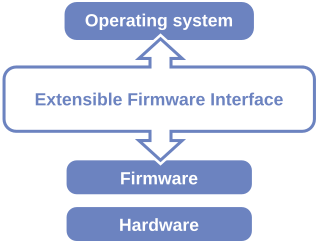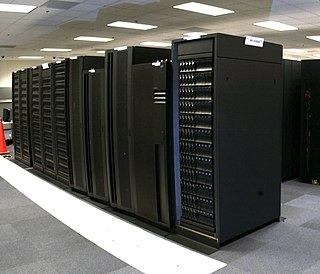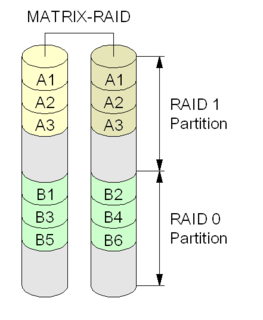Related Research Articles
RAID is a data storage virtualization technology that combines multiple physical disk drive components into one or more logical units for the purposes of data redundancy, performance improvement, or both. This was in contrast to the previous concept of highly reliable mainframe disk drives referred to as "single large expensive disk" (SLED).

A workstation is a special computer designed for technical or scientific applications. Intended primarily to be used by one person at a time, they are commonly connected to a local area network and run multi-user operating systems. The term workstation has also been used loosely to refer to everything from a mainframe computer terminal to a PC connected to a network, but the most common form refers to the class of hardware offered by several current and defunct companies such as Sun Microsystems, Silicon Graphics, Apollo Computer, DEC, HP, NeXT and IBM which opened the door for the 3D graphics animation revolution of the late 1990s.
NetWare is a discontinued computer network operating system developed by Novell, Inc. It initially used cooperative multitasking to run various services on a personal computer, using the IPX network protocol.

The Unified Extensible Firmware Interface (UEFI) is a publicly available specification that defines a software interface between an operating system and platform firmware. UEFI replaces the legacy Basic Input/Output System (BIOS) firmware interface originally present in all IBM PC-compatible personal computers, with most UEFI firmware implementations providing support for legacy BIOS services. UEFI can support remote diagnostics and repair of computers, even with no operating system installed.

A diskless node is a workstation or personal computer without disk drives, which employs network booting to load its operating system from a server.
In computing, a hybrid drive is a logical or physical storage device that combines a faster storage medium such as solid-state drive (SSD) with a higher-capacity hard disk drive (HDD). The intent is adding some of the speed of SSDs to the cost-effective storage capacity of traditional HDDs. The purpose of the SSD in a hybrid drive is to act as a cache for the data stored on the HDD, improving the overall performance by keeping copies of the most frequently used data on the faster SSD.

A solid-state drive (SSD) is a solid-state storage device that uses integrated circuit assemblies to store data persistently, typically using flash memory, and functioning as secondary storage in the hierarchy of computer storage. It is also sometimes called a solid-state device or a solid-state disk, even though SSDs lack the physical spinning disks and movable read–write heads used in hard disk drives (HDDs) and floppy disks.

The IBM Storage product portfolio includes disk, flash, tape, NAS storage products, storage software and services. IBM's approach is to focus on data management.

Oracle VM VirtualBox is a free and open-source hosted hypervisor for x86 virtualization, developed by Oracle Corporation. Created by Innotek, it was acquired by Sun Microsystems in 2008, which was in turn acquired by Oracle in 2010.

Dell Vostro is a line of business-oriented laptop and desktop computers manufactured by Dell aimed at small businesses. From 2013–2015, the line was temporarily discontinued on some Dell websites but continued to be offered in other markets, such as Malaysia and India.

Intel Rapid Storage Technology (RST), until 2010 called Matrix RAID, is a firmware-based RAID solution built into a wide range of Intel chipsets. As of 2020, it includes a RAID system capable of RAID levels 0, 1, 5, and 10, a block level SSD caching accelerator with support for write-back and write-through modes for speed or data protection of any disk or RAID array, and support for intelligent caching, speedy recovery from certain issues, and for PCI Express based drives. Intel RST comes in two variants, RST for desktops, and RSTe for enterprise scenarios, although for many chipsets, the user can choose as both variants will operate correctly.
A trim command allows an operating system to inform a solid-state drive (SSD) which blocks of data are no longer considered to be 'in use' and therefore can be erased internally.
A hybrid array is a form of hierarchical storage management that combines hard disk drives (HDDs) with solid-state drives (SSDs) for I/O speed improvements.
SandForce was an American fabless semiconductor company based in Milpitas, California, that designed flash memory controllers for solid-state drives (SSDs). On January 4, 2012, SandForce was acquired by LSI Corporation and became the Flash Components Division of LSI. LSI was subsequently acquired by Avago Technologies on May 6, 2014 and on the 29th of that same month Seagate Technology announced its intention to buy LSI's Flash Components Division.
NVM Express (NVMe) or Non-Volatile Memory Host Controller Interface Specification (NVMHCIS) is an open, logical-device interface specification for accessing a computer's non-volatile storage media usually attached via PCI Express (PCIe) bus. The acronym NVM stands for non-volatile memory, which is often NAND flash memory that comes in several physical form factors, including solid-state drives (SSDs), PCI Express (PCIe) add-in cards and M.2 cards, the successor to mSATA cards. NVM Express, as a logical-device interface, has been designed to capitalize on the low latency and internal parallelism of solid-state storage devices.
In computer data storage, Smart Response Technology is a proprietary caching mechanism introduced in 2011 by Intel for their Z68 chipset, which allows a SATA solid-state drive (SSD) to function as cache for a hard disk drive (HDD).
Flashcache is a disk cache component for the Linux kernel, initially developed by Facebook since April 2010, and released as open source in 2011. Since January 2013, there is a fork of Flashcache, named EnhanceIO and developed by sTec, Inc.
Bcache is a cache in the Linux kernel's block layer, which is used for accessing secondary storage devices. It allows one or more fast storage devices, such as flash-based solid-state drives (SSDs), to act as a cache for one or more slower storage devices, such as hard disk drives (HDDs); this effectively creates hybrid volumes and provides performance improvements.
dm-cache is a component of the Linux kernel's device mapper, which is a framework for mapping block devices onto higher-level virtual block devices. It allows one or more fast storage devices, such as flash-based solid-state drives (SSDs), to act as a cache for one or more slower storage devices such as hard disk drives (HDDs); this effectively creates hybrid volumes and provides secondary storage performance improvements.

3D XPoint is a non-volatile memory (NVM) technology developed jointly by Intel and Micron Technology. It was announced in July 2015 and is available on the open market under the brand name Optane (Intel) since April 2017. Bit storage is based on a change of bulk resistance, in conjunction with a stackable cross-gridded data access array. Initial prices are less than dynamic random-access memory (DRAM) but more than flash memory.
References
- ↑ "Intel® Cache Acceleration Software Explained Simply". intel.com. Retrieved 2019-01-25.
- 1 2 3 Intel releases SSD cache acceleration software for Linux servers - Computerworld
- ↑ "Intel Cache Acceleration Software (Intel CAS) Version 2.0 for Windows" (PDF). intel.com. Retrieved 2013-12-20.
- ↑ "Intel serves flashy speed to penguins after eating Nevex's cache". theregister.co.uk. Retrieved 2013-12-20.
- ↑ "Nevex reverses cache rules to accelerate apps". theregister.co.uk. Retrieved 2013-12-20.
- ↑ Nevex Speeds Apps With Caching System - InformationWeek
- 1 2 Intel Cache Acceleration Software - YouTube
- 1 2 Intel Cache Acceleration Software: FAQ Configuration and Use
- ↑ "Support for Intel® Cache Acceleration Software".
- ↑ New Intel CAS-W: Accelerating Software Application Performance - Direct2Dell - Direct2Dell - Dell Community
- ↑ Intel Cache Acceleration Software with Dell and Autodesk - YouTube